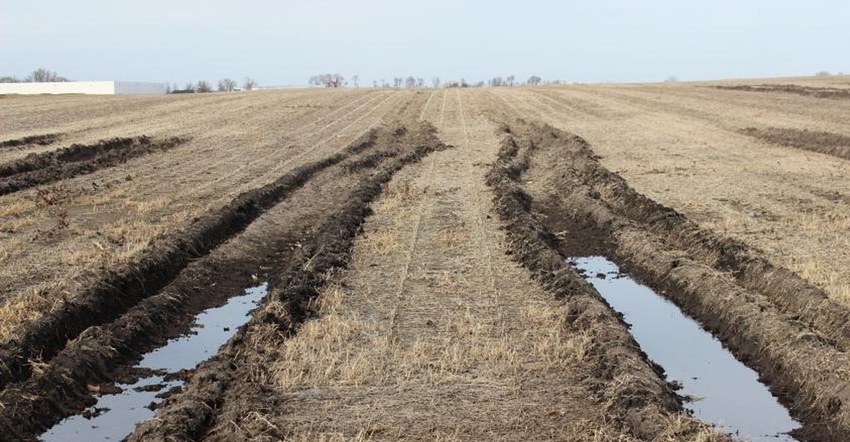October 15, 2018

By Mark Licht and Mahdi Al-Kaisi
Excessive rain in September and October has created challenging conditions not only for timely harvest of corn and soybean crops, but also for the impact harvest will have on the soil. These wet conditions coupled with a drop in the air temperature will slow harvest operations.
Soils are too wet for traffic from heavy equipment, making them susceptible to compaction during harvest. When soils are nearly saturated, driving on them with heavy equipment and loads of grain weakens soil structure where water works as a lubricant, leading to the collapse of soil aggregates. This will cause significant surface compaction, rutting and deep subsoil compaction.
Compaction damage will haunt you
Damage from soil compaction can have significant impact on water infiltration, root development and, ultimately, grain yield the following season. It’s generally estimated that yield loss due to soil compaction caused by wheel traffic ranges between 10% to 20% depending on the extent of the compaction.
Over the past decade, the size of Iowa farms has increased, leading to larger and heavier equipment. An axle load from a 12-row combine with full grain tank is estimated at 26 tons per axle and a single-axle fully loaded grain cart is estimated at 22 tons per axle.
Avoiding field conditions prone to soil compaction will likely be something you won’t be able to do this fall. Farmers will try to get grain harvested without further field preharvest yield losses and worsening grain quality. Soil compaction will be worse the wetter the soil conditions are.
Take care to avoid wet and near-saturated soils. Ideally, field operations would be delayed until soil water is below field capacity. Tillage, energy, time and costs could increase a hundredfold to remediate excessively compacted soils that were compacted during harvest operations.
Follow these tips
Tips to minimize soil compaction during and after harvest
1. Dedicated travel lanes. Many combine operators use “on-the-go” unloading into a grain cart to speed harvest. In areas that have received excessive rainfall since Sept. 1, farmers may want to consider having dedicated travel lanes for the grain cart. It has been documented that 60% to 80% of soil compaction occurs from the first wheel passes, subsequent field operations account for a much smaller amount of compaction.
2. Don’t run at full capacity. Reduce the axle loads of both the combine and grain carts by not loading them to full capacity. This may not be an attractive option in high-yielding cornfields and where harvest has already been delayed. This is much easier to do in soybean fields where the grain volume is much less than corn. A compromise may be to try and keep axle loads lower in the far reaches of fields and achieve the highest axle loads (full capacity) nearest the end rows where grain will be transported out of the field.
3. Tire size and inflation pressure. Use appropriate tire sizes for the conditions and adjust tire air pressure to match the axle load being carried. Larger tires with lower air pressure provide more surface area, allow for better flotation, and reduce pressure on the soil surface.
4. Concentrate nonharvest activates near field’s exit. While it’s tempting to move semi-trailers and tractors with wagons along the field edge as harvest continues, this practice increases compaction along the end rows.
5. Harvest around the wettest areas. The wettest areas are the most at risk for soil compaction but are also an accident risk that ultimately could lead to longer harvest delays. Additionally, buried equipment may come with large financial penalties. Come back to these areas later in the fall once the soil conditions are drier or have frozen.
6. Avoid or minimize tillage. Hold off tillage operations until soil conditions are drier than field capacity. It’s important to consider soil moisture at the depth of tillage. Tillage in wet conditions results in further compaction and smearing of soil instead of the intended fracturing of the soil. If it’s necessary to cosmetically fill in ruts, use a disk unless soil conditions are dry enough for fracturing of the soil through use of more aggressive implements.
In wet conditions, the best choice farmers can make is to stay away from the field and avoid traffic on wet soil to reduce soil compaction. How you approach fieldwork after a heavy rain event can impact your soil for future growing seasons.
Mark Licht is an ISU Extension cropping systems agronomist at Ames. Mahdi Al-Kaisi is a professor of agronomy and extension soil and water specialist at Iowa State University.
Easy test checks soil conditions
Most of Iowa's soils have medium textures. For these soils, a simple method of checking soil moisture is the "feel" method. Probing the top 12 to 18 inches with a hand soil probe to assess the field's soil moisture conditions is time well spent.
Check the soil moisture status by pushing a ribbon of soil from between your thumb and index finger. If it breaks off within 1 or 2 inches, the potential for creating compaction is less. However, if the ribbon stretches out to 4 or 5 inches, the soil is still too wet. Chances are good that being in the field under these conditions may cause more problems than it will solve.
Another soil consistency test is to roll soil against the palm of your hand to determine if it will clump and roll, or if it is fragile and falls apart. Soil that clumps together is more prone to compaction.
For more information read these online resources: Top 10 Reasons to Avoid Soil Compaction and Understanding and Managing Soil Compaction.
You May Also Like




